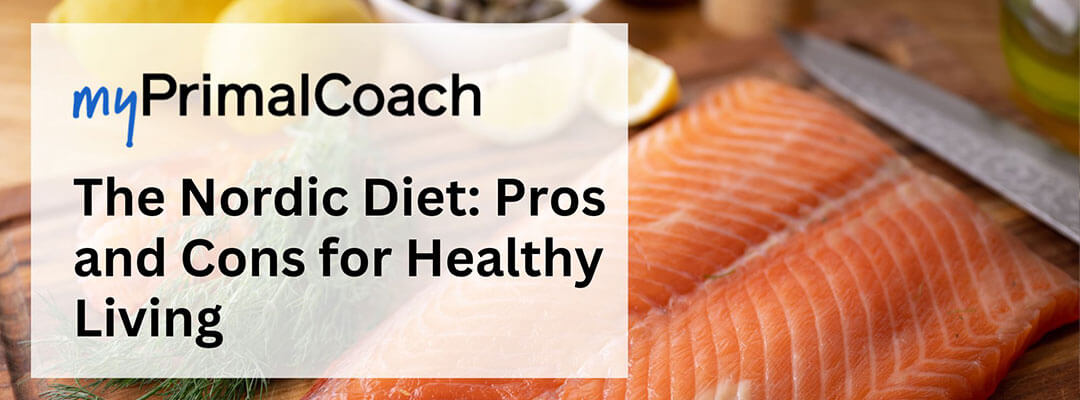There's more to the Nordic diet than eating a bucketload of seafood.

The Nordic diet was developed to improve health and reduce the environment impact of farming in the region.
It's been around for over twenty years, and was developed to improve health outcomes and farming practices in the Nordic region.
In recent years, the Nordic diet has gained popularity outside of Scandinavia for its alluring health benefits.
In this post we’ll explore the pros and cons of the Nordic diet and highlight some of the key differences between the Nordic diet and the Primal diet.
The Origins of the Nordic Diet
The Nordic diet was created in 2004 by a group of chefs, nutritionists, and scientists to boost public health and address unsustainable farming practices in Nordic countries. These health-promoting dietary patterns were developed by Scientists at the University of Denmark in Copenhagen, who brought in the co-founder of the world’s best restaurant, Noma, for a multi-year project. Noma is known for its focus on foraging and the modern cuisine of Scandinavia.
With a world renowned chef at the helm, it may come as no surprise that the diet focuses less on weight loss and more on consuming delicious, locally sourced healthy foods.
The Nordic Diet Defined
The Nordic diet is very similar to the popular Mediterranean diet in that it borrows the eating habits of one particular region. Originating from the northern European countries of Denmark, Norway, Sweden, Iceland and Finland, the diet embraces Nordic food culture. It emphasizes the consumption of local ingredients including seafood, whole grains, legumes, and vegetables. Moreover, the consumption of processed and packaged foods, added sugars, and red meat is discouraged.
The average American diet has too much processed food to be considered good for the heart. What we love about the Nordic diet, is its strong diet emphasis on eating real seasonal foods, similar to the Mediterranean diet. The Nordic diet also has twice the fiber when compared to the average Western diet. Fresh seasonal vegetables and fish consumption make up the bulk of the nutrients consumed on the Nordic diet. This differs greatly from the average diet in other Western countries.
What to Eat on a Nordic Diet
The Nordic diet was created with environmental sustainability and mindful eating of local produce at its core. Seasonal foods take center stage. To help you make the best food choices, we’ve created a list of foods to eat liberally, another list of foods to eat in moderation and an additional list of foods to avoid when following a Nordic diet.
Foods to Eat Liberally
These nutrient dense foods can be eaten in abundance:
- Fish—aim for two or three servings a week of fatty fish, the richest dietary source of omega-3s. The best choices are salmon, mackerel and herring.
- Wild shellfish such as oysters
- Local fruits—particularly seasonal wild berries which are high in dietary phytochemicals, antioxidants, flavonoids, and other bioactive compounds.
- Cruciferous vegetables—kale, cabbage, Brussels sprouts, horseradish, cauliflower, radish, turnips, and broccoli contain health-boosting dietary phytochemicals.
- Root vegetables—especially those that grow well in mild climates, such as potatoes.
- Seeds and nuts—boost your vitamin E levels and make for a tasty snack between meals.
- Whole grains like barley, oat, Swedish whole-grain crackers and Danish rye bread (Rugbrød), contain complex carbs and fiber.
- Chickpeas and other legumes are a rich protein source.
- Fermented dairy—preferably low-fat dairy such as filmjölk.
- Fermented foods such as pickled cabbage and onion are great for gut health.
- Herbs
- Spices
Foods to Eat in Moderation
The following foods can be eaten in moderation:
- Free-range eggs
- Cheese
- Game meats, select lean proteins.
- Locally-farmed meat—choose lean meat of high quality.
- Canola oil
Foods to Limit
The Nordic diet suggests limiting your intact of the following foods:
- Red meats other than game.
- Whole fats such as butter and other animal fats.
Foods to Avoid
The Nordic diet recommends avoiding the following foods and beverages:
- Refined sugars.
- Processed snacks.
- Sugar-sweetened beverages.
- Food additives.
- Grilled, smoked, and processed meats.
- Refined fast foods.
- White breads and refined flours.
Pros of the Nordic Diet
There are some major pros when it comes to the Nordic diet:
Environmentally Benefits
With an emphasis on local foods and an origin rooted in addressing unsustainable farming practices, the Nordic diet offers a big nod to the planet. Diets that emphasize plant consumption typically require fewer natural resources and create less pollution than diets reliant on large-scale commercial farming. Sourcing local, organic, and seasonal foods cuts the carbon footprint and brings us back to basics.
Potential Health Benefits
Lowers Blood Pressure
A 2014 study found that the Nordic diet reduced blood pressure in obese people. A separate study conducted that same year found a significant reduction in diastolic blood pressure in those with metabolic syndrome. These studies suggest that a Nordic diet reduces cardiovascular risk factors.
Reduces Inflammation
Another study showed a healthy Nordic diet reduced inflammation compared to a control diet by reducing the expression of genes related to inflammation in fat tissues.
Lowers Blood Sugar Levels
A study conducted at the beginning of 2022 revealed beneficial effects of the Nordic diet with blood sugar—just 6 months of compliance could possibly lower glucose in the blood.
Diversity & Balance
The Nordic diet calls for the consumption of a large variety of foods leaving little room to feel deprived or bored. This allows for a sense of satiety given the robust intake of healthy fats, protein, and carbohydrates from seafood and vegetables. Not to mention, local, real food tastes good! The diet is well-balanced, including all food groups and in reasonable proportions.
Cons of the Nordic Diet
All lifestyles have their drawbacks, and the Nordic diet is no exception. Here are some of the most striking cons to the Nordic diet:
Weight Management
Will you lose weight? Possibly. Will you keep it off? Results aren’t promising. In one study, participants dropped more pounds while following a Nordic diet compared to those following the standard Danish way of eating. However, a subsequent study conducted one year later found that those following the Nordic diet gained most of the weight back. The sustainability of weight loss on the Nordic diet is uncertain.
Time-Consuming
As with any diet with rigid guidelines, eating out and finding pre-made food isn’t always easy. To commit to this way of eating requires planning, shopping, and time in the kitchen. Sourcing local food may prove difficult as well. Popping by your local grocery store to pick up some arugula for dinner may turn into a farmer’s market trip in order to ensure it’s local.
Expensive
In an ideal world, healthy, organic, and local food would be more affordable than packaged goods. Until we reach that point, following a clean diet full of high-quality produce and animal products may require some redistribution of your budget.
The Nordic Diet Compared to the Primal Diet
Similarities
Both the Primal diet and Nordic diet agree on many aspects of what constitutes a healthy way of eating, and one big component in particular—the consumption of real, whole foods and the absence of packaged foods and sugar. High-quality animal products and organic produce is a focus of both diets as well as a shunning of additives, refined, and processed foods. Both diets recommend consuming wild fish and shellfish, antioxidant-rich berries, fiber-packed vegetables, nuts and seeds, fermented foods, herbs and spices, high quality eggs, and game meats.
Differences
The two ways of eating disagree in several important areas. Grains and legumes are a definitive no in the Primal world yet are emphasized in the Nordic diet. While the Nordic diet suggests moderating the consumption of free-range eggs and game meats, the Primal diet places no limitations on these categories. The Nordic diet also suggests limiting the consumption of red meats and other animal fats, while the Primal diet encourages them. Another point of contrast is the Nordic diet’s recommendation of low-fat dairy. The Primal diet places dairy in an area of limbo but prioritizes full-fat and raw varieties.
The preferred cooking oil used in the Nordic diet is canola. The Primal lifestyle stays on top of new data and perspectives and has updated its stance on vegetable oils over the years. However, canola oil is not on the list of recommended Primal foods for several reasons, including the extraction process and prevalence of genetically modified seed varieties. As of 2013, GMO canola made up 95% of canola planted.
Summary
The Nordic diet does not align completely with a Primal lifestyle. But the health effects of the Nordic diet appear very promising, especially if you accompany a Nordic eating pattern with regular physical activity and stress management strategies. The Nordic diet has the potential to keep chronic diseases at bay.
As new diets and trends are perpetually emerging, one foolproof method to ensure you meet your nutritional needs is to stick to real, whole, unprocessed foods, and healthy fats.
Primal or Nordic? There’s no need to choose between the two. Trial and error is a solid approach to figuring out what works best for you. Consistency and long-term adherence to any lifestyle changes is key to optimal health and well-being. Having personalized nutrition and health coaching, as offered in our myPrimalCoach program, is an excellent tool to help guide you in figuring out what makes you feel your best and will be sustainable.

